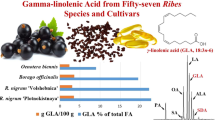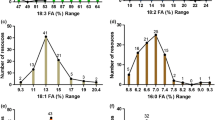Abstract
This paper reports the fatty acid and triacylglycerol (TAG) compositions of five Amaranthus accessions (RRC1011, R149, A.K343, A.K432, and A. K433) representing two species and a cross between one of these and a third species. Seed oils of these were analyzed by gas chromatography and reversed-phase high-performance liquid chromatography, and their compositional properties compared with buck-wheat (Fagopyrum esculentum), corn (Zea mays), rice bran (Oryza sativa), soybean (Glycine max L. Merr.), sesame (Sesamum indicum), quinoa (Chenopodium quinoa), and cottonseed (Gossypium hirsutum) oils. All Amaranthus accessions were relatively high in palmitic (21.4–23.8%) and low in oleic (22.8–31.5%) and linolenic (0.65–0.93%) acids when compared to most of the grain and seed oils. The fatty acid composition of Amaranthus accessions K343, K433, and K432 (group I) were different from R149 and RRC1011 (group II) in mono and polyunsaturated fatty acids, but the saturate/unsaturate (S/U) ratios were very similar. All Amaranthus accessions were similar in TAG type, but showed slight differences in percentage. High similarities in UUU, UUS, and USS composition were observed among Amaranthus K343, K433 and K432, and between R149 and RRC1011. The fatty acid compositions of Amaranthus oil (group I) and cottonseed oil were similar, but their TAG compositions were different. The grain and oilseed oils were different from each other and from the Amaranthus accessions oils in terms of fatty acid composition, S/U, and TAG ratios. The UUU, UUS, and USS percentages were very diverse in grain and seed oils. The percentages of squalene in the TAG sample from the Amaranthus accessions were 8.05% in K343, 11.10% in K433, 11.19% in K432, 9.96% in R149, and 9.16% in RRC1011. Squalene was also tentatively identified in quinoa and ricebran oils at levels of 3.39 and 3.10%, respectively.
Similar content being viewed by others
References
Lehmann, J.W., Case History of Grain Amaranthus and Alternative Crop, Cereal Foods World 41:399–411 (1996).
Sauer, J.D. Grain Amaranths, in Evolution of Crop Plants, edited by N.W. Simmonds, Longman Inc., New York, 1979, pp. 4–7.
Budin J.T., W.M. Breen, and D.H. Patnum, Some Compositional Properties of Seeds and Oils of Eight Amaranthus Species, J. Am. Oil Chem. Soc. 73:475–481 (1996).
Saunders, R.M., and R. Becker, Amaranthus: A Potential Food and Feed Resource, Adv. Cereal Sci. Technol. 6:357–396 (1985).
Bressani, R., The Proteins of Grain Amaranth, Food Rev. Int. 5:13–38 (1989).
Sun, H., D. Wiesenborn, K. Tostenson, J. Gillespie, and P. Rayas-Duarte, Fractionation of Squalene from Amaranth Seed Oil, J. Am. Oil Chem. Soc. 74:413–418 (1997).
Sun, H., D. Wiesenborn, P. Rayas-Duarte, A. Mohamed, and K. Hagen, Bench-Scale Processing of Amaranth Seed for Oil, J. Am. Oil Chem. Soc. 72:1551–1555 (1995).
Official Methods and Recommended Practices of the American Oil Chemists' Society, American Oil Chemists' Society, Champaign, 1992, Method Ce 2-66, and 1995, Ce 5b-89.
Przybylski, R., G.S. Chauhan, and N.A.M. Eskin, Characterization of Quinoa (Chenopodium quinoa) Lipids, Food Chem. 51:187–192 (1994).
Sonntag, N.O.V., Composition and Characteristics of Individual Fats and Oils, Bailey's Industrial Oil and Fat Products, edited by Daniel Swern, John Wiley & Sons, Inc., New York, 1979, Vol. 1, pp. 289–456.
Lyon, C.K., and R. Becker, Extraction and Refining of Oil from Amaranth Seed, J. Am. Oil Chem. Soc. 64:233–236 (1987).
Bondioli, P., C. Mariana, A. Lanzani, E. Fedeli, and A. Muller, Squalene Recovery from Olive Oil Deodorizer Distillates, 70:763–766 (1993).
Author information
Authors and Affiliations
Corresponding author
About this article
Cite this article
Jahaniaval, F., Kakuda, Y. & Marcone, M.F. Fatty acid and triacylglycerol compositions of seed oils of five Amaranthus accessions and their comparison to other oils. J Amer Oil Chem Soc 77, 847–852 (2000). https://doi.org/10.1007/s11746-000-0135-0
Received:
Accepted:
Issue Date:
DOI: https://doi.org/10.1007/s11746-000-0135-0




